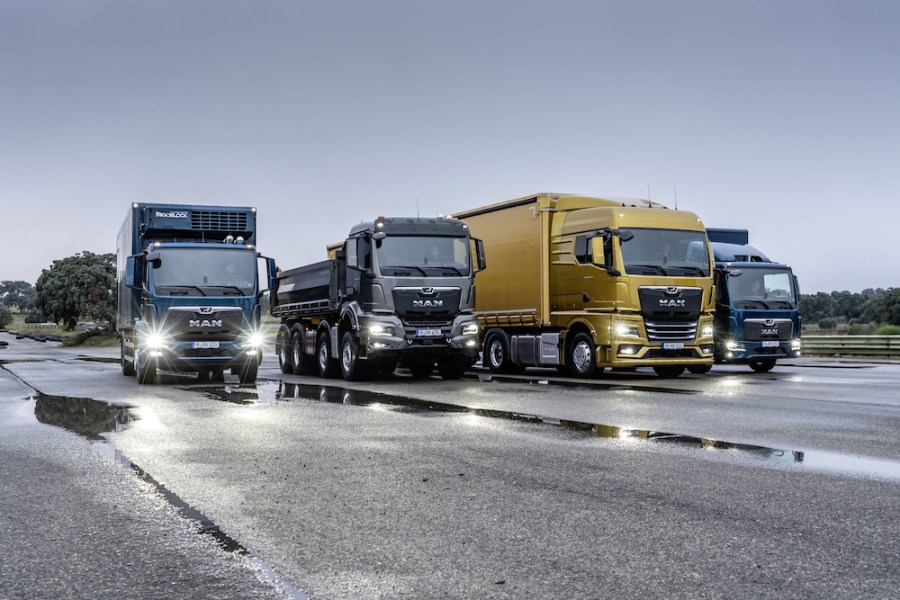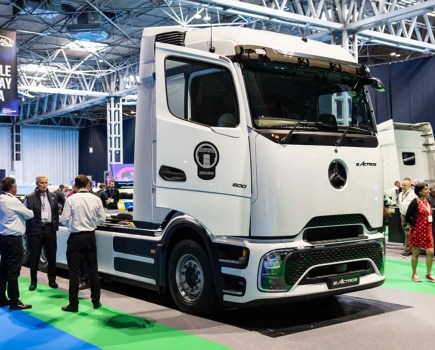MAN has uncovered its new TG range including a new flagship TGX – and driver acceptance is very much in focus. A completely new cab, boosted fuel efficiency and a host of innovations usher in a bold new chapter for the German marque.
Billed as its most important launch in 20 years, German truck-maker MAN has finally taken the wraps off its all-new TG series with the debut of updated TGX, TGL, TGM and TGS models covering operation at 7.5-41 tonnes. At a packed launch event held at the Port of Bilbao, Spain, company boss Joachim Drees introduced the vehicles as “the best MANs of all time” that “set new standards for cleaner, smarter and safer transportation”.
The project has been in development for the last five years, with trucks undertaking over 4 million test km ahead of their market launch. Old and new models will be on the market for the next 18-24 months during the transition.
Leading the launch was the new TGX (see our test drive here) – which, in 4×2 form on long-haul ops, offers a fuel saving of eight per cent compared to Euro 6c predecessor, said Drees. This is a cumulative saving based on using the D26 Euro 6d engine launched last year, with aerodynamic refinements to the cab and an optimised hypoid drive axle named as other significant factors. MAN refrained from making similar claims for the new TGL, TGM and TGS chassis.
TG is also being offered in an Individual Lion variant, which provides a range of extra options (eg, increased interior storage, daytime driving lights, exterior sun visor etc) to enable operators and drivers to enhance their vehicles and make customer-specific adaptations to ensure a perfect fit for purpose.
TG options
MAN’s new long-haul flagship is available with a choice of three engines: D38 developing up to 640 bhp, mid-range D26 from 430-510 bhp, and lighter D15 from 330-400 bhp. Axle configurations are 4×2, 6×2, 6×4 and heavy-haul 8×4. Those ordering 4×2 variants can specify MAN’s HydroDrive hydrostatic front-axle drive system, which can help with grip on off-road surfaces. GVW for TGX ranges from 18-41 tonnes, with a maximum GTW of 250 tonnes for specialist weight applications.
TGS is geared towards heavy-duty distribution, construction and municipal operations. Sporting narrower cabs, TGS can be spec’d with D26 or D15 engines with power ranging from 330-510 bhp. Regular axle configurations are 4×2, 6×2, 6×4, 8×2, 8×4, while all-wheel drive 4×4, 6×6, 8×6 or 8×8 variants can be taken for working on rougher terrain. HydroDrive can be combined with a two, three- or four-axle TGS if the vehicle is mainly driven on decent roads and off-roading is infrequent. TGS GVWs range from 18-41 tonnes.
For light and medium-weight missions, TGL and TGM can be spec’d with four different cab types: short, long, high with bed, and crew. TGL comes in a single 4×2 flavour, covers 7.5-12 tonne operation and can sport the four-cylinder D08 engine from 160-220 bhp, or the six-cylinder D08 at 250 bhp for some extra grunt. TGM stretches from 12-26 tonnes GVW, can be fitted with D08 engines from 250-320 bhp, and can be taken in 6×2, 6×4 or 4×4 wheel configurations.
Evolution on the outside
At first glance, the new cabs are more of an evolutionary step up from the previous TG generation. There are eight cab sizes, all of which have been tweaked to keep air resistance as low as possible. Exterior mirror casings are narrower, front panels have more efficient wind deflectors, and new roof spoilers and side flaps on some cab types further help direct air flow around the truck.
The three biggest cabs are GX, GM and GN. The GX and GM sleepers are 2.44 m wide and have two external lockers (which can be opened from the inside), boosted internal storage (especially above the windscreen) and decent headroom: 2.07 m for GX and 1.87 m for GM.
The GN variant has a lower roof and offers 1.57 m headroom. All three cab types have beds with thicknesses up to 110 mm, resting on slatted frames.
Narrower TGL, TGM and TGS cabs measure 2.24 m wide. The FM cab has the same high roof as the GM and is aimed at payload-sensitive long-haul, while the low FN sleeper model is for occasional overnighting where a higher roof isn’t required.
For TGS, the 1.88 m long NN cab will suit tipper and mixer chassis. Though we didn’t get a decent look at the launch, we were told the cab will have enough space behind the seats for stowing kit, an optional access ladder coupled with grab handle on the roof and standing platform on the wheel arch for easier load observation. Medium- and high chassis cabs will also sport reinforced three-part steel bumpers and flexible lower steps.
Finally, TGL and TGM can be spec’d with compact CC cab with 2.24 m width and 1.62 m length, or DN low-roof crew cab which can accommodate up to seven people.
MAN said the new TG cabs will be used as the platform for battery-electric (and possibly fuel-cell electric) models using the new TRATON powertrain, which MAN said it is gearing for launch in 2023/24.
Revolution on the inside
Drivers will find plenty that’s new in the new TG range. The cabs are now fully digital, with a high-resolution and glare-free 12.3 inch colour screen replacing the main instrument dials. The centre section shows info relating to driver assistance tools such current speed limit, supply levels, vehicle parameters etc.
These are accessed via buttons on the redesigned steering wheel, which now has multifunction controls grouped together more sensibly and a slightly thinner feel in hand (though it’s still on the chunkier side). The range of adjustment for the driving column has also increased (as has seat travel and height), meaning lanky or shorter drivers can achieve a better driving position.
MAN has also repositioned the gear stalk to the right-hand side of the wheel, and an electronic parking brake control now sits up on the dashboard.
At the top of the centre console sits a 9 inch HD screen that relays infotainment such as sat nav, media, phone etc. MAN said it has deliberately avoided installing touch screens in the latest range as they can distract the driver, preferring instead to develop a bespoke twin-dial control called SmartSelect – and this is perhaps one of new TG’s biggest innovations.
SmartSelect enables the driver to rest their hand on the control and use the screens without having to move their attention away from the road. The larger bottom dial switches through modes (radio, phone, sat nav etc), a press selects the required mode, then the top dial enables fine control within each mode.
What’s more, the top of the dial is a touchpad which the driver can use to scroll through maps, or type out letters to quickly sort sort through phone contacts. A robust fold-out wrist rest keeps things comfortable. We had a quick play and it feels smart, surprisingly responsive and takes little time to learn.
Digital future
At the heart of the new range is an all-new electronic architecture which has been largely produced in-house. Rather than overly rely on third-party suppliers, MAN has coded 70 per cent of the system itself to ensure integration with current and future systems are as painless as possible via over-the-air upgrades. This, said the manufacturer, will help boost reliability. This system also enables the new TG series form the platform for future BEV and FCEV variants. In addition, MAN bosses told Trucking self-driving capabilities and digital mirrors are also very much on the cards, with the introduction of both likely to occur within the next 12 months.
British first!
British driver Mark Coventry drove the new flagship Individual Lion TGX onto the stage in front of the world’s media in Bilbao. Mark is a driver for Bideford-based Evans Transport, has been driving MANs for 22 years and was invited to Munich to be the very first to test drive the new vehicle ahead of its big reveal. We caught up him right after his star turn to get his first impressions of the new TGX.
“I’m just glad I didn’t mess up getting onto the stage!” he laughs. “I reckon I must have done about 3 million kilometres behind the wheel of an MAN. I think the first thing that struck me about the new model is the level of interior space – it just feels much more spacious. The SmartSelect control is brilliant – the wrist guard makes it really comfortable to use and keeps your hand in place, even if you’re moving in the air-sprung seat.
“It feels a lot smoother to drive. Where the older TG could sometimes have a delayed response from the accelerator, this new one just wants to go. There’s no need to play with the handbrake now it’s disengaged automatically when you touch the accelerator. The ride is smoother than the previous generation. The steering wheel is smaller and thinner, so you’re not swinging it around so much. The whole package has clearly been built around the driver.”






